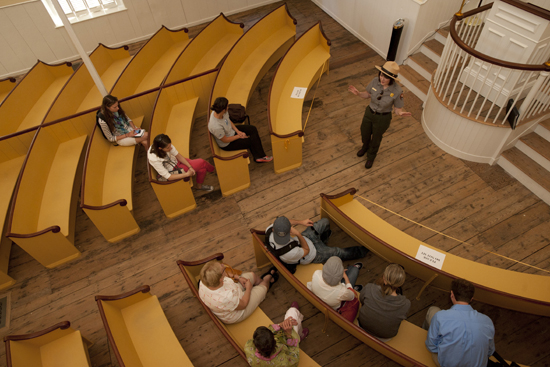Archaeology of Boston
Studying city’s history up close

PhD student Alexander Keim (CAS’04, GRS’14) explains the historical significance of Beacon Hill structures to students of his Archaeology of Boston class, which explores Boston’s history through visits to historical sites and archaeological excavations throughout the city. Photos by Vernon Doucette
Class by class, lecture by lecture, question asked by question answered, an education is built. This is one of a series of visits to one class, on one day, in search of those building blocks at BU.
On a weekday this summer, 10 students gathered at the Robert Gould Shaw and 54th Regiment Memorial, across from the Massachusetts State House, where they were met by National Park Service ranger Dorothy Rivera. After giving the group a brief history of the memorial, which celebrates the contribution of the first documented regiment of African Americans formed in the North to fight in the Civil War, Rivera led them on a walking tour of Boston’s Black Heritage Trail, giving them glimpses into a little-known and fascinating aspect of the city’s history.
The excursion was part of the six-week summer course Archaeology of Boston, taught by Alexander Keim (CAS’04, GRS’14), a College of Arts & Sciences archaeology doctoral student. Keim says the class is designed to give students an opportunity to learn about the daily lives of Boston’s early residents by exploring artifacts and excavations throughout the city.
“We approach the history of Boston in a different perspective,” he says. “It’s a fun, nice way to learn about things—not sitting in a lecture hall for four hours.”
That said, each archaeological excursion is accompanied by a two-hour lecture and plenty of reading. In the classroom lecture following this particular trip, Keim discussed the history of African Americans in Boston and the archaeology of some of the sites they’d seen that day.
After talking about the Robert Gould Shaw and 54th Regiment Memorial, designed by sculptor Augustus Saint-Gaudens, the class proceeded to the Phillips School, a 19th-century schoolhouse that admitted only white children until the Massachusetts legislature abolished segregated schools in 1855. The school was among the first in the city to be integrated. Rivera and Keim discussed black Bostonians’ tireless efforts throughout the 19th century to achieve equal educational rights.

Next on the tour was a visit to the John J. Smith House, named for the noted African American abolitionist and state legislator. Students learned that Smith had owned a nearby barbershop that was a major gathering place for members of Boston’s 19th-century African American and abolitionist communities as well as a stopping point on the Underground Railroad.
After several other stops, the tour concluded at the African Meeting House, tucked away on a tiny side street on Beacon Hill. Built by free black laborers at the start of the 19th century, the structure, believed to be the oldest black church building in the country, played a pivotal role in the life of Boston’s free black community.
Rivera had the rapt attention of the students with her anecdotes of life in the city during the American Revolution and the Civil War, with contributions from Keim, who jumped in with his own observations. Together, they made for lively tour guides.
By the end of the walk, students said they had a much greater appreciation for what life was like in 19th-century Boston.
Among other trips the class took during the course were a visit to the Rose Kennedy Greenway to take in excavation sites from the Big Dig, the Paul Revere House, where students met with a senior scientist for the Massachusetts Department of Conservation and Recreation, and a tour of the Shawmut Peninsula, in Charlestown.
Adam Vitale’s favorite was a trip to Chapel Rock in Squantum, a neighborhood in Quincy, where the class had an opportunity to get dirty searching for paleo-Indian shell middens, or waste heaps. “We used GPS devices to find and document where they were,” says Vitale (CGS’12, CAS’14). “It was pretty cool, and it was the first real archaeology thing I’ve done.”

The class’ interactive approach has not only been popular, but has proven an effective learning tool. Nancy Stutzman, an Evergreen program (for those over 58) student, had taken a number of art history classes before Archaeology of Boston. “Being able to experience up front the subject matter of archaeology is something you can’t do with art history,” she says. Christina Janansky (CAS’14, COM’14) also appreciated that aspect of the course. “To actually get a hands-on experience is awesome,” says Janansky.
Keim, who is pursuing a PhD in historical archaeology and worked on digs in Tuscany as an undergraduate, hopes that the class—which covers topics ranging from gender, eating, and drinking to race, hygiene, and death—has given his students a “better understanding of the history of Boston from the perspective of the people who don’t usually make it into the history books.
“Boston is rich in its archaeological record of its entire human occupation,” he says, noting that the city’s oldest archaeological site (a stone projectile point located at what is now the Boston Common Frog Pond) is somewhere between 3,000 and 8,000 years old. The Big Dig and many downtown construction projects, he says, have allowed archaeologists to find new deposits of artifacts all over the city.
Andreia DeVries can be reached at adevries@bu.edu.
This Series
Also in
One Class, One Day
-
November 30, 2018
Breaking Bad Director Gives CAS Class the Inside Dope
-
October 31, 2018
Trump and the Press: We’ve Been Here Before
-
August 3, 2018
A Scholarly Take on Superheroes

Comments & Discussion
Boston University moderates comments to facilitate an informed, substantive, civil conversation. Abusive, profane, self-promotional, misleading, incoherent or off-topic comments will be rejected. Moderators are staffed during regular business hours (EST) and can only accept comments written in English. Statistics or facts must include a citation or a link to the citation.